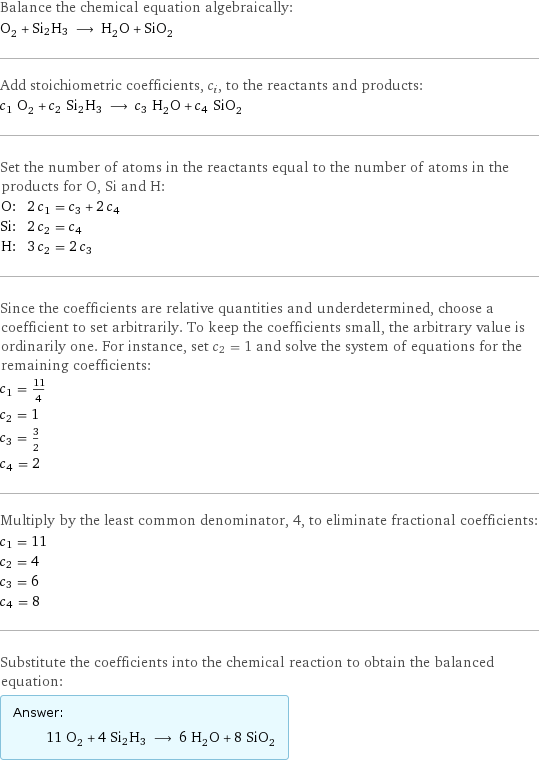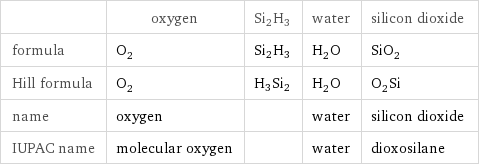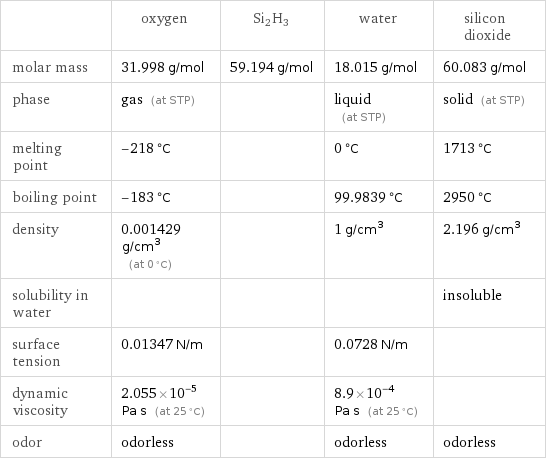Input interpretation

O_2 oxygen + Si2H3 ⟶ H_2O water + SiO_2 silicon dioxide
Balanced equation

Balance the chemical equation algebraically: O_2 + Si2H3 ⟶ H_2O + SiO_2 Add stoichiometric coefficients, c_i, to the reactants and products: c_1 O_2 + c_2 Si2H3 ⟶ c_3 H_2O + c_4 SiO_2 Set the number of atoms in the reactants equal to the number of atoms in the products for O, Si and H: O: | 2 c_1 = c_3 + 2 c_4 Si: | 2 c_2 = c_4 H: | 3 c_2 = 2 c_3 Since the coefficients are relative quantities and underdetermined, choose a coefficient to set arbitrarily. To keep the coefficients small, the arbitrary value is ordinarily one. For instance, set c_2 = 1 and solve the system of equations for the remaining coefficients: c_1 = 11/4 c_2 = 1 c_3 = 3/2 c_4 = 2 Multiply by the least common denominator, 4, to eliminate fractional coefficients: c_1 = 11 c_2 = 4 c_3 = 6 c_4 = 8 Substitute the coefficients into the chemical reaction to obtain the balanced equation: Answer: | | 11 O_2 + 4 Si2H3 ⟶ 6 H_2O + 8 SiO_2
Structures

+ Si2H3 ⟶ +
Names

oxygen + Si2H3 ⟶ water + silicon dioxide
Equilibrium constant
![Construct the equilibrium constant, K, expression for: O_2 + Si2H3 ⟶ H_2O + SiO_2 Plan: • Balance the chemical equation. • Determine the stoichiometric numbers. • Assemble the activity expression for each chemical species. • Use the activity expressions to build the equilibrium constant expression. Write the balanced chemical equation: 11 O_2 + 4 Si2H3 ⟶ 6 H_2O + 8 SiO_2 Assign stoichiometric numbers, ν_i, using the stoichiometric coefficients, c_i, from the balanced chemical equation in the following manner: ν_i = -c_i for reactants and ν_i = c_i for products: chemical species | c_i | ν_i O_2 | 11 | -11 Si2H3 | 4 | -4 H_2O | 6 | 6 SiO_2 | 8 | 8 Assemble the activity expressions accounting for the state of matter and ν_i: chemical species | c_i | ν_i | activity expression O_2 | 11 | -11 | ([O2])^(-11) Si2H3 | 4 | -4 | ([Si2H3])^(-4) H_2O | 6 | 6 | ([H2O])^6 SiO_2 | 8 | 8 | ([SiO2])^8 The equilibrium constant symbol in the concentration basis is: K_c Mulitply the activity expressions to arrive at the K_c expression: Answer: | | K_c = ([O2])^(-11) ([Si2H3])^(-4) ([H2O])^6 ([SiO2])^8 = (([H2O])^6 ([SiO2])^8)/(([O2])^11 ([Si2H3])^4)](../image_source/b4e61b9bbb601701a9500c7c8c8ee769.png)
Construct the equilibrium constant, K, expression for: O_2 + Si2H3 ⟶ H_2O + SiO_2 Plan: • Balance the chemical equation. • Determine the stoichiometric numbers. • Assemble the activity expression for each chemical species. • Use the activity expressions to build the equilibrium constant expression. Write the balanced chemical equation: 11 O_2 + 4 Si2H3 ⟶ 6 H_2O + 8 SiO_2 Assign stoichiometric numbers, ν_i, using the stoichiometric coefficients, c_i, from the balanced chemical equation in the following manner: ν_i = -c_i for reactants and ν_i = c_i for products: chemical species | c_i | ν_i O_2 | 11 | -11 Si2H3 | 4 | -4 H_2O | 6 | 6 SiO_2 | 8 | 8 Assemble the activity expressions accounting for the state of matter and ν_i: chemical species | c_i | ν_i | activity expression O_2 | 11 | -11 | ([O2])^(-11) Si2H3 | 4 | -4 | ([Si2H3])^(-4) H_2O | 6 | 6 | ([H2O])^6 SiO_2 | 8 | 8 | ([SiO2])^8 The equilibrium constant symbol in the concentration basis is: K_c Mulitply the activity expressions to arrive at the K_c expression: Answer: | | K_c = ([O2])^(-11) ([Si2H3])^(-4) ([H2O])^6 ([SiO2])^8 = (([H2O])^6 ([SiO2])^8)/(([O2])^11 ([Si2H3])^4)
Rate of reaction
![Construct the rate of reaction expression for: O_2 + Si2H3 ⟶ H_2O + SiO_2 Plan: • Balance the chemical equation. • Determine the stoichiometric numbers. • Assemble the rate term for each chemical species. • Write the rate of reaction expression. Write the balanced chemical equation: 11 O_2 + 4 Si2H3 ⟶ 6 H_2O + 8 SiO_2 Assign stoichiometric numbers, ν_i, using the stoichiometric coefficients, c_i, from the balanced chemical equation in the following manner: ν_i = -c_i for reactants and ν_i = c_i for products: chemical species | c_i | ν_i O_2 | 11 | -11 Si2H3 | 4 | -4 H_2O | 6 | 6 SiO_2 | 8 | 8 The rate term for each chemical species, B_i, is 1/ν_i(Δ[B_i])/(Δt) where [B_i] is the amount concentration and t is time: chemical species | c_i | ν_i | rate term O_2 | 11 | -11 | -1/11 (Δ[O2])/(Δt) Si2H3 | 4 | -4 | -1/4 (Δ[Si2H3])/(Δt) H_2O | 6 | 6 | 1/6 (Δ[H2O])/(Δt) SiO_2 | 8 | 8 | 1/8 (Δ[SiO2])/(Δt) (for infinitesimal rate of change, replace Δ with d) Set the rate terms equal to each other to arrive at the rate expression: Answer: | | rate = -1/11 (Δ[O2])/(Δt) = -1/4 (Δ[Si2H3])/(Δt) = 1/6 (Δ[H2O])/(Δt) = 1/8 (Δ[SiO2])/(Δt) (assuming constant volume and no accumulation of intermediates or side products)](../image_source/d526316ea70d634d13234d9a3525622a.png)
Construct the rate of reaction expression for: O_2 + Si2H3 ⟶ H_2O + SiO_2 Plan: • Balance the chemical equation. • Determine the stoichiometric numbers. • Assemble the rate term for each chemical species. • Write the rate of reaction expression. Write the balanced chemical equation: 11 O_2 + 4 Si2H3 ⟶ 6 H_2O + 8 SiO_2 Assign stoichiometric numbers, ν_i, using the stoichiometric coefficients, c_i, from the balanced chemical equation in the following manner: ν_i = -c_i for reactants and ν_i = c_i for products: chemical species | c_i | ν_i O_2 | 11 | -11 Si2H3 | 4 | -4 H_2O | 6 | 6 SiO_2 | 8 | 8 The rate term for each chemical species, B_i, is 1/ν_i(Δ[B_i])/(Δt) where [B_i] is the amount concentration and t is time: chemical species | c_i | ν_i | rate term O_2 | 11 | -11 | -1/11 (Δ[O2])/(Δt) Si2H3 | 4 | -4 | -1/4 (Δ[Si2H3])/(Δt) H_2O | 6 | 6 | 1/6 (Δ[H2O])/(Δt) SiO_2 | 8 | 8 | 1/8 (Δ[SiO2])/(Δt) (for infinitesimal rate of change, replace Δ with d) Set the rate terms equal to each other to arrive at the rate expression: Answer: | | rate = -1/11 (Δ[O2])/(Δt) = -1/4 (Δ[Si2H3])/(Δt) = 1/6 (Δ[H2O])/(Δt) = 1/8 (Δ[SiO2])/(Δt) (assuming constant volume and no accumulation of intermediates or side products)
Chemical names and formulas

| oxygen | Si2H3 | water | silicon dioxide formula | O_2 | Si2H3 | H_2O | SiO_2 Hill formula | O_2 | H3Si2 | H_2O | O_2Si name | oxygen | | water | silicon dioxide IUPAC name | molecular oxygen | | water | dioxosilane
Substance properties

| oxygen | Si2H3 | water | silicon dioxide molar mass | 31.998 g/mol | 59.194 g/mol | 18.015 g/mol | 60.083 g/mol phase | gas (at STP) | | liquid (at STP) | solid (at STP) melting point | -218 °C | | 0 °C | 1713 °C boiling point | -183 °C | | 99.9839 °C | 2950 °C density | 0.001429 g/cm^3 (at 0 °C) | | 1 g/cm^3 | 2.196 g/cm^3 solubility in water | | | | insoluble surface tension | 0.01347 N/m | | 0.0728 N/m | dynamic viscosity | 2.055×10^-5 Pa s (at 25 °C) | | 8.9×10^-4 Pa s (at 25 °C) | odor | odorless | | odorless | odorless
Units
